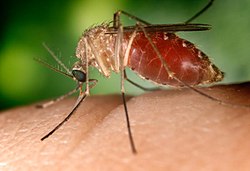| Skeeter syndrome | |
|---|---|
 | |
| Culex mosquito on a human finger | |
| Symptoms | Redness, heat, abnormal swelling surrounding bite site, pus, pain at the site |
Skeeter syndrome (papular urticaria) is a localized severe allergic reaction to mosquito bites, [1] consisting of inflammation, peeling skin, blistering, ulceration and sometimes fever. It is caused by allergenic polypeptides in mosquito saliva, and therefore is not contagious. [2] It is one of several forms, being one of the most severe, of allergic responses to mosquito bites, termed mosquito bite allergies. [3]
Contents
The condition may vary between individuals based on the reaction size and severity. Some individuals may experience reactions only to some bites and not others, thought to be attributed to varying reactions to different species of mosquitoes.
Although the term seems informal, it has appeared in scientific literature. [4]
